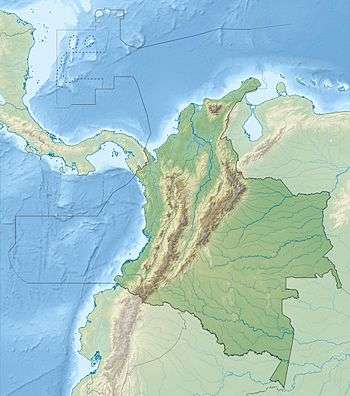Ituango Dam
| Ituango Dam | |
|---|---|
 Location of Ituango Dam in Colombia | |
| Official name | Pescadero-Ituango "José Tejada Sáenz" |
| Country | Colombia |
| Location | Ituango |
| Coordinates | 7°11′36″N 75°34′40″W / 7.19333°N 75.57778°WCoordinates: 7°11′36″N 75°34′40″W / 7.19333°N 75.57778°W |
| Status | Under construction |
| Construction began | 2011 |
| Opening date | 2018 (est.) |
| Construction cost | US$2.8 billion |
| Dam and spillways | |
| Type of dam | Embankment, earth-fill clay core |
| Impounds | Cauca River |
| Height | 225 m (738 ft) |
| Dam volume | 19,000,000 m3 (670,000,000 cu ft) |
| Spillway type | Service, gate controlled |
| Spillway capacity | 22,600 m3/s (800,000 cu ft/s) |
| Reservoir | |
| Total capacity | 2,720×106 m3 (2,210,000 acre·ft) |
| Active capacity | 980×106 m3 (790,000 acre·ft) |
| Surface area | 38 km2 (15 sq mi) |
| Max. length | 127 km (79 mi) |
| Power station | |
| Operator(s) | EPM Ituango |
| Commission date | 2018 |
| Hydraulic head | 197 m (646 ft) (nominal) |
| Turbines | 8 x 307 MW (412,000 hp) Francis type |
| Installed capacity | 2,456 MW (3,294,000 hp) (planned) |
| Annual generation | 9,200 GWh (33,000 TJ) (firm) |
|
Website http://www.hidroituango.com.co (Spanish) | |
The Ituango Dam, also referred to as the Pescadero-Ituango Dam, is an embankment dam currently under construction on the Cauca River near Ituango in Antioquia Department, Colombia. The primary purpose of the project is hydroelectric power generation and its power plant is expected to have an installed capacity of 2,456 megawatts (3,294,000 hp). Preliminary construction on the dam began in September 2011 and the power plant is set to begin operations in 2018.[1] When completed, it will be the largest power station in Colombia.[2]
Background
The dam's feasibility study was completed in 1983 but the project was shelved in the 1990s due to an economic crisis.[3] The final designs for the project were finished in 2008 and on 8 July 2011, the project management contract was awarded. Preliminary construction (surveying, roads, bridges, diversion tunnels) began in September 2011 and it is expected to be complete in 2013.[4] Main works will begin thereafter and the power plant is expected to being commissioning in 2018. Development of the project is being proposed by EPM Ituango, a consortium of Empresas Publicas de Medellin (EPM) and the Antioquia government. The total cost is expected to be US$2.8 billion.[5][6]
Design
The dam will be a 225-metre (738 ft) tall earth-fill embankment type with a clay core. The volume of the dam will be 19 million cubic metres (670×106 cu ft). Its reservoir will have a capacity of 2,720-million-cubic-metre (2,210,000 acre·ft) of which 980-million-cubic-metre (790,000 acre·ft) will be active (or "useful") capacity. The reservoir will be 127 kilometres (79 mi) long and cover an area of 38 square kilometres (15 sq mi). To maintain reservoir levels, the dam will have a spillway controlled by two radial gates with a design flow of 22,600 cubic metres per second (800,000 cu ft/s). The dam's power plant will have a nominal hydraulic head of 197 metres (646 ft) and contain eight 307 megawatts (412,000 hp) Francis turbine-generators.[7]
See also
References
- ↑ "Chadbourne Represented EPM Ituango in BOOMT Contract for the 2400 MW Hidroituango Project". 28 April 2011. Retrieved 9 July 2011.
- ↑ "China, South Korea companies in race for Colombia hydropower deal". Colombia Reports. 3 February 2010. Retrieved 9 July 2011.
- ↑ "Colombia hydro utility to build 2,688-MW Pescadero Ituango". HydroWorld. 7 December 2011. Retrieved 9 July 2011.
- ↑ "Construction preparation begins for 2,400-MW Ituango in Colombia". Hydro World. 22 September 2011. Retrieved 29 March 2012.
- ↑ "Evolution of Expansion Plans" (PDF). EPM. Retrieved 9 July 2011.
- ↑ "Consortium wins US66 million contract for Ituango hydro project build in Colombia". HydroWorld. 8 July 2011. Retrieved 9 July 2011.
- ↑ "Datos Técnicos" (in Spanish). Hidroeléctrica Ituango. Retrieved 9 July 2011.